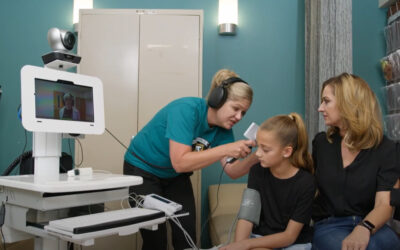By FRANK TUTALO, Sun Staff
With a little help from the federal government, a local medical products company is eyeing Scandinavia for future sales.
AMD Telemedicine Inc. was one of seven U.S. companies to take part in a health care trade mission last week, in which participants visited Denmark, Norway and Sweden to explore business opportunities. The five-day trip was coordinated by the Commerce Department, with the intent of increasing U.S. exports to the region.
“We’re interested in expanding to that market,” said Mark VanderWerf, president of AMD, an 18-employee, privately-held company headquartered on Middle Street. “They have very good national health care programs, and a very spread-out geography which makes it difficult to implement. Telemedical products provide a direct benefit because of those two factors.”
AMD manufactures and markets medical products that are developed by doctors and hospitals, such as video microscopes and vital-sign monitors. Its systems allow patient information to be transmitted over telephone lines, allowing caregivers to remotely diagnose, monitor and treat patients.
The company, which came to Shattuck Street from Boston’s North End around 1995, started in 1991 by selling a sterilizer developed by NASA. It later refocused its efforts to telemedicine. Now, people in 55 countries at 2,000 sites use AMD’s products, most of which sell for between $5,000 and $20,000.
VanderWerf, a Westford resident, said not enough companies “look beyond the borders of the U.S.,” and lauded the Commerce Department for helping set up meetings with potential distributors and future partners. His company records 40 percent of its sales from outside the country, though he noted only a small portion of that comes from Scandinavia.
But demand is there and the market is growing.
According to the Commerce Department, Denmark’s import medical market is estimated at $375 million, and telemedicine is one of the fastest-growing trends in Danish health care. Sweden, considered one of the most advanced medical equipment markets in the world, imports an estimated $850 million in medical equipment and technology. And Norway spends more of its gross domestic product on medical care than any other country except the U.S. and Switzerland. “Scandinavian health-care consumers appreciate the quality of American-made products, and these firms represent some of the best in ingenuity and innovation,” Neal Burnham, deputy assistant secretary for export promotion services with the U.S. Commercial Service, said in a statement.
The U.S. Commercial Service, a unit of the Commerce Department, helps U.S. businesses, particularly small and mid-sized companies, make international sales. The organization has some 110 offices in 161 countries.
AMD, meanwhile, has offices in Australia and Texas, but will likely call Lowell its home for the foreseeable future. VanderWerf said the company is “bursting at the seems” in its current office, and has been contacted by the Boott Mill to relocate there, to a bigger space in a mill building now under renovation.
“We’ll probably stay in Lowell, and it’s convenient for most of our employees,” he said. “Frankly, I like being in the center of a city. You have access to so many things that you don’t get at an office park.”
About AMD Telemedicine
AMD Global Telemedicine is the leading, worldwide supplier of telemedicine equipment and technology devices used in telemedicine with more than 5,000 installed sites in 74 countries. AMD devices and tConsult™ software products offer clinically acclaimed, cost-effective solutions for the most challenging medical applications. AMD also provides complete technical support in program design, device integration, training, and remedial service to assure a successful program implementation. For more information on AMD Telemedicine, please visit www.amdtelemedicine.com, email pr@amdtelemedicine.com,or call 866-511-0923.



